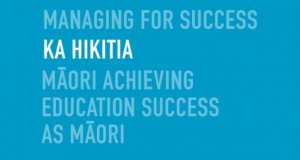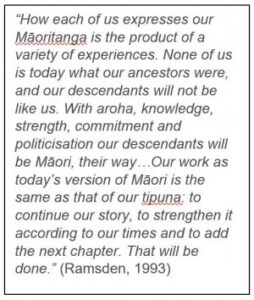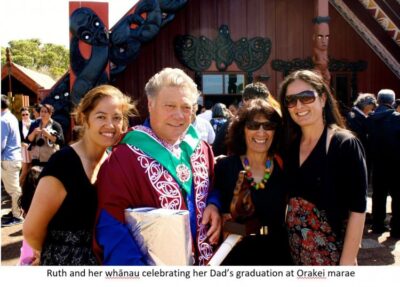Māori achieving success as Māori
By Ruth Tate on October 30, 2017 in Cultural capability
What’s your community’s vision?
The vision of Ka Hikitia is that Māori learners enjoy education success as Māori. While many schools have recognised that this vision is important and worthy of attention, success as Māori has proved an enigmatic notion for many schools. What does it mean, to enjoy success as Māori? What does it look like and how would we know if it’s happening or not?
Quite understandably, a lot of schools and Kāhui Ako have taken the approach of focusing on what can be more easily understood and measured – academic achievement; schools have set clear achievement targets for Māori learners, and closely monitored achievement in relation to those targets. Commendably, many schools have worked hard to reduce the achievement disparity between Māori and other learners in a valid attempt to enact the vision of Ka Hikitia.

Where I believe this approach falls short, however, is that the vision for Māori learners in Ka Hikitia does not focus solely on academic success but on Māori learners succeeding “in their lives as Māori”. To focus only on the academic achievement of Māori learners fails to recognise and value, I believe, the language, culture and identity of Māori learners. And, I think, if schools are genuine and committed to improving educational outcomes for Māori learners, then understanding what success as Māori looks like is an important step towards achieving this.
“As Māori [means] being able to have access to te ao Māori, the Māori world – access to language, culture, marae… tikanga… and resources… If after twelve or so years of formal education, a Māori youth were totally unprepared to interact within te ao Māori, then, no matter what else had been learned, education would have been incomplete.”
Professor Mason Durie, (2003). Ngā Kahui Pou: Launching Māori Futures. Huia Publications
I commend those schools that have taken some significant steps to understanding what success as Māori looks like in their school or community. This has led to deep inquiry into ways the school and/or Kāhui Ako can identify the conditions and practices under which Māori learners can succeed. What follows are some thoughts about how and why you too might take this step.
Defining what success as Māori looks like in your setting
I think this is a great first step to take as a school. It involves becoming clear in your own community about what is valued. Without a clear picture of what this looks like, how can we know what we’re aiming for? Without this picture, how can we know if we’ve achieved it or not? Without this vision of success, how can we measure how successful Māori learners are as Māori? How can we even talk about something if we don’t have a shared vision of what “it” is’? In some schools, this vision of success has been captured in the graduate profile. If your school has a graduate profile, is the profile lived in your school setting or buried somewhere in the school charter?
The purpose of exploring success with your community is to ensure that you have a holistic and shared view of what your Māori community aspires to. For too long, schooling for Māori learners has involved understanding and valuing the wider world without giving mana to our own Māori world. This process begins a journey towards legitimising Māori by validating Māori views of success. Defining what success as Māori looks like does not need to exclude discussions about academic success. When you talk to your Māori community you will see that language, culture and identity and academic achievement are interwoven and, I believe, complementary.
It is often said, “we value what we can measure”. At present, achievement data largely defines the story of Māori success (or failure). However, another worthy saying I heard recently is this: “Not everything that counts can be counted, and not everything that can be counted, counts.” So I’m not advocating that we quantify cultural identity and track ‘countable’ gains, but I think we need a way to describe the extent to which Māori learners feel they are able to stand proudly, participate in and contribute to their Māori world. The purpose is not to be able to measure this, but to give mana to this aspect of a tamaiti’s development, to support them to work towards learning and growing in this dimension of who they are. It would also provide a broader and perhaps more meaningful picture of a tamaiti’s achievement.This leads me to my next point..
Recognising universal Māori and particular iwi aspirations
Some of the key aspirations I believe you would see across iwi include the importance of the re-generation of te reo Māori and the re-generation of whānau and hapū, not just the individual. These concepts come through strongly in the kōrero on our marae and in iwi education plans. These are key concepts that I believe you would want to look for in what you develop with your community, wherever that community is.
However, it is important to recognise that Māori are not a homogenous group. What Te Rarawa on one side of my whakapapa promote and value may be similar to those of my Ngāpuhi side, but there will be differences according to iwi. For this reason, it’s important as a leader in a school to work alongside local iwi to understand their aspirations for their tamariki and then decide with your Māori community how to reflect this in your vision statement.
This quote from a student is, I think, a good example of what this might look like.
“Learning about my tribal affiliations and history is one of the cool aspects here. Our Raukawatanga is woven through the kura. Teachers help us to grow in our language and tikanga – including both Māori and Ngāti Raukawa dimensions.” Ka Hikitia Managing for Success, page 26.

Whakawhānaungatanga – creating stronger partnerships with your Māori community
The beauty of partnering with your Māori community to define success in your setting is that the mana or ownership is rightfully shared between the school and the Māori community. Success as Māori is about hearing and understanding Māori voices, Māori stories. There is, I believe, still an absence of Māori perspectives and Māori world views in most English medium schools. This needs to change if Māori learners are able to thrive. Leaders need to enable their Māori communities to lead this process and tell their story. This for me is about the cultural competency referred to in Tātaiako as tangata whenuatanga.
Co-constructing the vision of success with your Māori community to my mind opens the door for authentic partnership because it involves working collaboratively with Māori parents and whānau and Māori learners on a kaupapa that is important to them – the success of their tamariki. Furthermore, working together to discuss how and why you would measure this will involve ako or opportunities to learn from each other.
Often consultation is experienced by parents and whānau as a one-way street –“here’s how we think it should be, do you have any suggestions?” I think better is to set up the conditions for your community to be listened to and heard.
Where to start?
So how could a school embark on this journey? Where should you start? How about this for an idea… start with one student, or one parent. A couple of paragraphs back I wrote about the importance of hearing and understanding Māori voices, Māori stories. Here’s one Māori voice – mine. Here is what success as Māori means to me:
Being Māori for me is knowing that where I live does not necessarily mean the place I identify as ‘home’. Home for me is the land that gave life to my tupuna, home of family weddings and birthday celebrations. The place where we mourn and bury our dead and where, someday, I too will rest.
Being Māori for me is knowing my whakapapa and knowing how each branch connects.
Being Māori for me is about understanding and being able to use te reo o te Nota (the dialect of the North).
Being Māori for me is knowing how we do things on my marae.
Being Māori for me is knowing that with the privilege of belonging to whānau, hapū and iwi comes the responsibility to be present and ensure our turangawaewae will be a place where future generations can find peace, identity, refuge and life.
Being Māori for me is about being an example for my whānau, hapū and iwi. It’s rejecting any notion that being Māori makes me inferior. It’s resisting the urge to suppress the beauty of my own heritage in order to blend in. It’s about being a lifelong advocate for my people, and working to make things better for Māori.
This is the legacy of those who have gone before me, and my destiny as Māori.
The funny thing is, I’ve been an educator for 15 years, a tertiary student for four years before that, a school student for 13 years before that, and no-one has ever asked me to describe this. It was hard to describe. It took me quite a while. But it makes me proud to be Māori to be given the opportunity to share it. If a student or parent at your school had a similar description, what could your school do to help him or her experience success as Māori?
- Ruth Tate

Other articles you might like
Was that Participation? Partnership? Protection? Or… Consultation?
Local curriculum is causing a buzz around many schools and I hear many leaders and teachers talking about what it means and what they should be doing. I firmly believe that every school has the main elements of their local curriculum alive and kicking within their walls – however, sometimes it is not recognised as such.
Leading the why and the how
